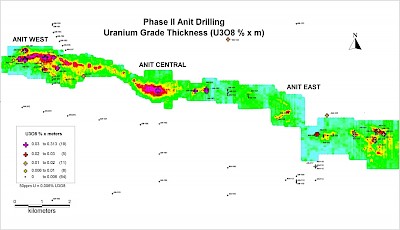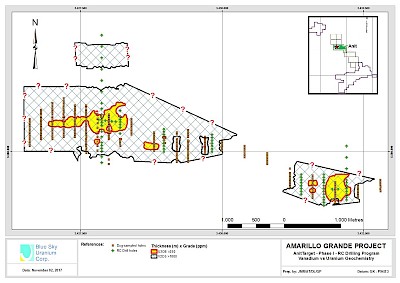Location and Access
The Anit Property lies between the Santa Barbara and Ivana properties within the 145 kilometre NW-SE Amarillo Grande uranium trend discovered by Blue Sky in the centre of Rio Negro province. Located at 100 kilometres north of Valcheta City, the property is situated in a topographic depression with year-round access through well-maintained gravel roads; the area is semi-arid with low rainfall and very low population density.
Discovery History
The Anit property was a grassroots discovery by Blue Sky in the centre of the new uranium district. The discovery was made during follow-up of results from the 2007 airborne radiometric survey that identified a 15 kilometre-long, and locally up to 1.5 kilometres wide, anomaly in the area.
Subsequent fieldwork included trenching, pit sampling, auger testing, radon gas surveys, and two aircore reverse circulation drill programs. This work culminated in the definition of more strongly mineralized and thicker portions of the mineralized paleochannel in the West and Central zones, as well as large areas of lower grade mineralization in the East zone. Within the mineralized zone outlined at the West and Central zones, including only pits with mineralization greater than 50 ppm Uranium over 1 metre, the average thickness of the mineralized layer was 1.97 metres with a weighted average grade of 0.04% U3O8 (337 ppm Uranium) and 0.10% V2O5 (594 ppm Vanadium)( see January 20, 2011 News Release). Mineralization was observed from surface up to 6 metres depth, but it is generally more concentrated in the upper 3 metres.
The Phase I reverse circulation (“RC”) drill program completed in 2017 included 1,170 metres of drilling in 83 holes, with a maximum hole depth of 20 metres. The program successfully confirmed the spatial correlation of the previously recognized mineralized zones, and led to the delineation of a significant area of vanadium mineralization, covering a much larger area than the previously defined uranium mineralized zone. This vanadium zone measures approximately 3 kilometres by 1 kilometre with thicknesses between <1 and +16 metres and grades ranging from 0.026% and 0.341% V2O5 (259ppm and 3,411ppm V2O5 respectively), using a 0.1% V2O5 x metre isocurve as a lower limit.
Initial interpretation of the observed spatial and quantitative relationship between the two metals may relate to initial concentration of vanadium-rich minerals in the paleochannel system, likely as vanadium-bearing oxide and/or hydroxide minerals, and subsequent formation of carnotite, incorporating a portion of the available vanadium upon introduction of uranium.
Additional exploration work to advance understanding of the mineralogy, metallurgical characteristics, grade and aerial extent of the vanadium mineralization at the Anit target will be incorporated into future exploration programs, which will include ground geophysics, RC drilling and mineralogy/metallurgical studies.
Local Geology
The majority of the uranium mineralization delineated to date is within 20 metres of surface and is hosted by unconsolidated clastic sediments, often below a thin veneer of unmineralized material. The uranium-vanadium mineral carnotite (K2(UO2)2(VO4)23H2O) is the predominant uranium mineral, with minor β-coffinite, tyuyamunite and liebigite; and occurs as coatings on grains of sand and pebbles. The sediments are interpreted as belonging to the upper section of the Chichinales formation of Middle Tertiary age.
Metallurgy
Independent preliminary metallurgical test work has demonstrated that the uranium and vanadium mineralized material from the Anit property can be inexpensively upgraded by wet screening mineralized material to remove coarse pebbles that contain little or no mineralization, producing a low-mass higher-grade concentrate (see news release dated February 7th, 2011). This has the potential to significantly reduce processing and transportation costs, making the development of several satellite deposits around one central processing facility a potential development scenario.
For additional details on the Anit Property please refer to the 2012 Technical Report and filings on SEDAR.

